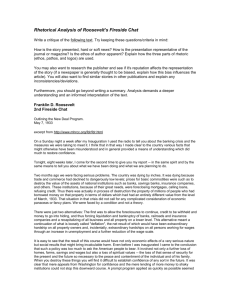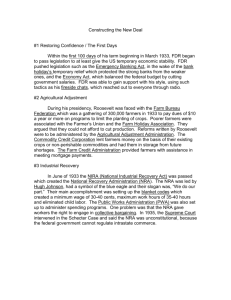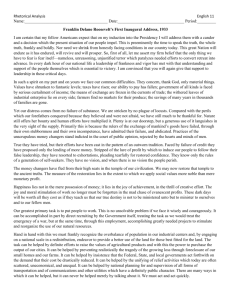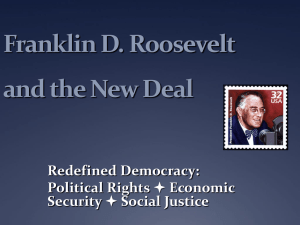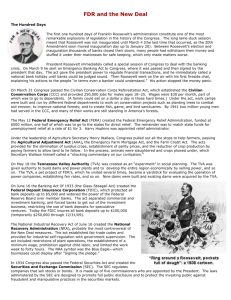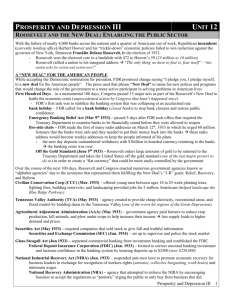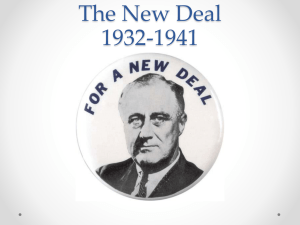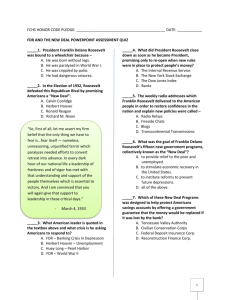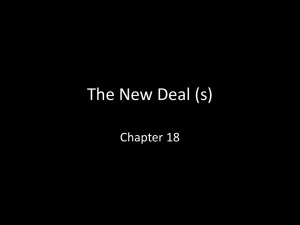FDR webquest - Elmwood Park Memorial High School
advertisement
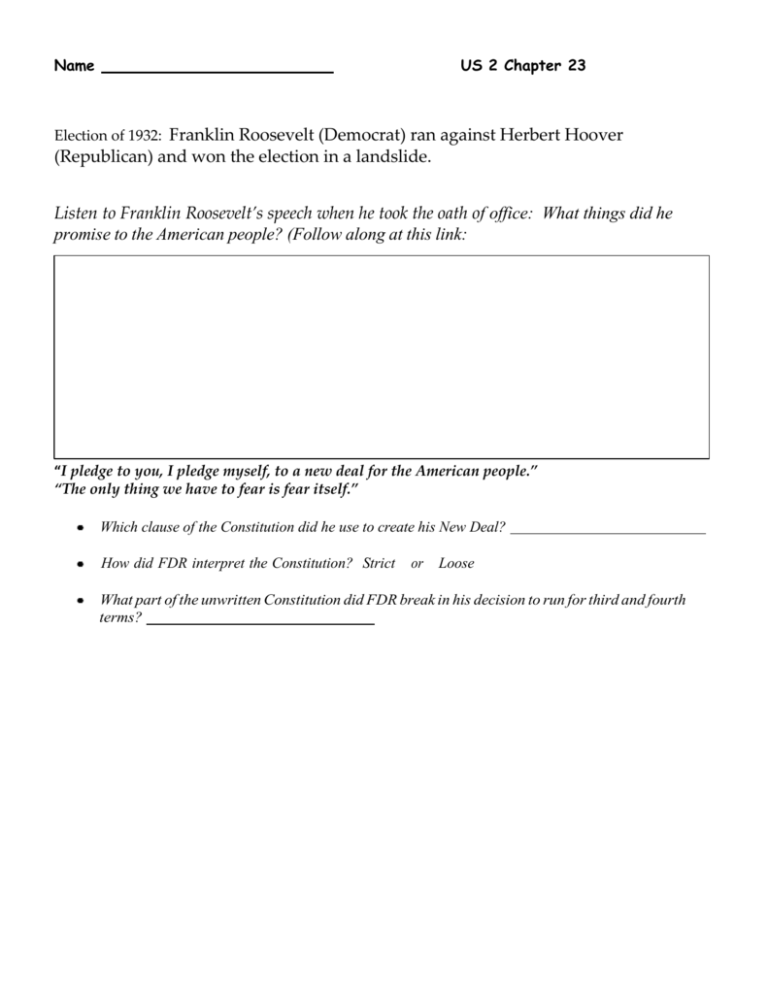
Name US 2 Chapter 23 Election of 1932: Franklin Roosevelt (Democrat) ran against Herbert Hoover (Republican) and won the election in a landslide. Listen to Franklin Roosevelt’s speech when he took the oath of office: What things did he promise to the American people? (Follow along at this link: The New Deal “I pledge to you, I pledge myself, to a new deal for the American people.” “The only thing we have to fear is fear itself.” Which clause of the Constitution did he use to create his New Deal? How did FDR interpret the Constitution? Strict or Loose What part of the unwritten Constitution did FDR break in his decision to run for third and fourth terms? Roosvelt’s First Hundred Days- March to June, 1933 The "bank holiday" and the Emergency Banking Act The desperate economic situation, combined with Democratic Party victories in the 1932 elections, gave Roosevelt unusual influence over Congress in the first months of his administration. He won rapid passage of a series of measures to prop up the tottering banking system, reform the stock market, aid the unemployed, and induce industrial and agricultural recovery…. he worked to shore up the existing financial institutions and to revive confidence in the economy. On March 6, two days after taking office, he issued a proclamation closing all U.S. banks for four days until Congress could meet in a special session. Ordinarily, such an action would cause widespread panic. But the action created a general sense of relief. First, many states had already closed down the banks before March 6. Second, Roosevelt astutely and euphemistically described it as a "bank holiday." And third, the action demonstrated that the federal government was stepping in to stop the alarming pattern of bank failures. Three days later, Roosevelt sent to Congress the Emergency Banking Act, designed primarily to protect large banks from being dragged down by the failing smaller ones. The bill provided for Treasury Department inspection of all banks before they would be allowed to reopen, for federal assistance to tottering large institutions, and for a thorough reorganization of those in greatest difficulty. A confused and frightened Congress passed the bill within four hours of its introduction. Three-quarters of the banks in the Federal Reserve System reopened within the next three days, and $1 billion in "hoarded" currency and gold flowed back into them within a month. The immediate banking crisis was over. The Agricultural Adjustment Act The Agricultural Adjustment Act, created the Agricultural Adjustment Administration (AAA), which Congress passed in May 1933. Relative farm incomes had been falling for decades. The most important provision of the AAA was the provision for crop reductions—the "domestic allotment" system of the act, which was intended to raise prices for farm commodities. Under this system, producers of seven basic commodities (corn, cotton, dairy products, hogs, rice, tobacco, and wheat) would decide on production limits for their crops. The government would then, through the AAA, tell individual farmers how much they should plant and would pay them subsides for leaving some of their land idle. . The most controversial component of the anti-deflationary domestic allotment system was the large-scale destruction of existing crops and livestock to reduce surpluses. At a time in which many families were suffering from malnutrition and downright starvation, it was a difficult measure. However, it worked. Other initiatives The First Hundred Days also saw the creation of a new federal regulatory agency to oversee the stock market, the Securities and Exchange Commission (SEC), a reform of the banking system that included a system of insurance for deposits. But the most successful in alleviating the miseries of the Great Depression were a series of relief measures to aid some of the 15 million unemployed Americans, among them the Civilian Conservation Corps (CCC), the Civil Works Administration (CWA), and the Federal Emergency Relief Administration (FERA). The early New Deal also began the Tennessee Valley Authority (TVA), an unprecedented experiment in flood control, public electric power, and regional planning. Roosevelt also moved in his first days in office to legalize the manufacture and sale of beer—an interim measure pending the repeal of prohibition, for which a constitutional amendment (the Twenty-first) was already in process. The amendment was ratified later in 1933. The National Industrial Recovery Act (NIRA), the most important undertaking of the first Hundred Days, was passed by Congress in June 1933. It guaranteed to workers of the right of collective bargaining and helped spur major union organizing drives in major industries. http://www.free-definition.com/New-Deal.html#The_First_Hundred_Days FDR Webquest Historical focus: Background on Franklin Delano Roosevelt http://www.whitehouse.gov/history/presidents/fr32.html 1. When was FDR elected to his first political office, and what was it? 2. What appointed position did he hold during Woodrow Wilson's administration? 3. What caused him to leave politics in 1920? 4. What disease did he contract in 1921, and what effect did it have on him? 5. When did FDR re-enter public office and what position was he elected to? 6. How many times was he elected President, and in what years? 7. Where and when did he die? Political Focus 1. How many times was FDR elected, and in what years? http://www.ipl.org/div/potus/fdroosevelt.html 2. Who was in his cabinet? Why was his appointment of his Secretary of Labor significant? http://www.multied.com/Bio/people/Perkins.html 3. What did he promise in his First Inaugural Address? http://www.bartleby.com/124/pres49.html 4. What does FDR say about one-third of the nation in his second inaugural? http://www.bartleby.com/124/pres50.html#28 5. What do political cartoons tell us about the first 100 days of his first term? http://www.nisk.k12.ny.us/fdr/FDRfirst100.html 6. What do political cartoons tell us about the Supreme Court in 1937? http://www.nisk.k12.ny.us/fdr/1937/index.html Geographic Focus 1. What impact did the TVA have on the people and the land? http://newdeal.feri.org/tva/index.htm 2. What was the impact of the CCC Camps in Utah? http://www.uen.org/utahlink/tours/tourFames.cgi?tour_id=13597 3. What patterns of migration were caused by the drought in the plains? What was the impact of this on the land and the people? http://lcweb2.loc.gov/ammem/afctshtml/tsme.html Economic Focus 1. New Deal Programs: Give the name and acronym for each of the following programs: http://faculty.washington.edu/qtaylor/Courses/101_USH/new_deal.htm Quickly gave money to people; provided vaccinations and literacy classes, too Employment and vocational training for needy young men through work in the conservation and development of natural resources To insure the deposits of approved banks against loss in the event of bank failure Created in 1934 to encourage residential construction, repair, and modernization by insuring loans and mortgages Public projects such as roads and bridges (San Francisco’s Golden Gate Bridge) were created as a result of this program Created in 1935 to protect employees in their rights to self-organization and collective bargaining Created in 1933 to operate government owned properties at Muscle Shoals, Ala; to develop water and power resources of the Tennessee River watershed Created to regulate the stock market 2. What is the Social Security Program? http://www.ssa.gov/history/brief.html How was it started? How does it work today? 3. How many were unemployed at different times during the depression? 1933 1934 http://newdeal.feri.org/timeline/1933a.htm http://newdeal.feri.org/timeline/1934b.htm 4. How was Unionism affected by the New Deal? strengthened .
